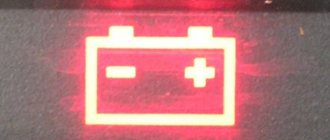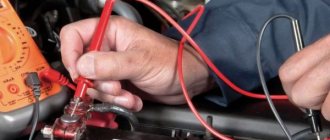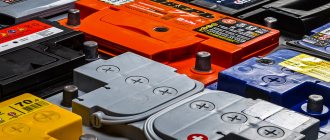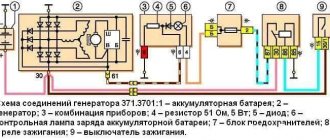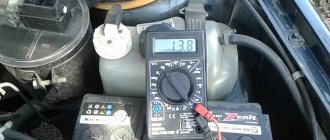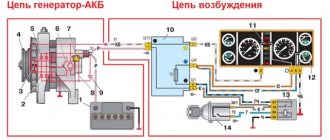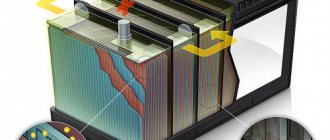Disputes regarding the correct charging of a calcium battery have been going on for a long time. One half of car owners advocates a voltage of 14.8 V (± 0.4 V) when charging, while the other claims that for a 100% charge of a calcium battery, a voltage of at least 16.0 V is required. At the same time, each side gives its own “ convincing” arguments to prove the infallibility of his theory. Let's try to figure out together what is the reason for such heated debates and is there the only correct way to charge a calcium battery?
For reference: the maximum soluble value of calcium (Ca) in lead (Pb) is 0.1% of the bulk. The lead plates of modern batteries contain from 0.06% to 0.09% calcium. This ratio was determined experimentally and is the most optimal.
Further reading will be useful in understanding why today traditional batteries with lead-antimony alloy grids are a thing of the past, and they have been replaced by batteries with lead-calcium alloy grids. Understanding these simple truths will help us see “from which side,” figuratively speaking, we need to approach charging calcium batteries.
No one wants the benefits of calcium batteries
Did you know that the first calcium battery was created in 1932 by an American company? At that time, this was the biggest progress in the lead-acid battery market, because these batteries acquired a number of advantages over traditional antimony batteries. They had much lower self-discharge (retained accumulated energy for a long time) and very low water consumption (they practically did not “boil” during operation), which made them the undisputed leaders in unpretentious maintenance.
It would seem that calcium batteries are the future! But no. In practice, “calcium” technology has not been widely used until now. Why? Because along with the advantages, calcium batteries also have significant disadvantages. Among them:
- It is difficult to obtain castings with a constant calcium content due to its rapid burnout during the melting process. This process was labor-intensive and financially expensive, which greatly hampered the spread of “calcium technology.”
- Significant loss of capacity of positive electrodes during deep discharges as a result of:
- intergranular corrosion of a lead-calcium alloy (Pb-Ca), which makes the positive electrode brittle and brittle, worsening its conductive properties;
- deterioration of contact between the current-carrying grid and the active mass due to the formation between them of a dense layer of lead sulfate (PbSO4), which “does not dissolve” (does not oxidize in PbO2) even when fully charged (apparently, it plays an important role in the formation of this layer calcium sulfate CaSO4);
- weak adhesion of the corrosion film to both the active mass and the current conductor, which increases the tendency of the active mass to melt.
- The difficulty of controlling the degree of charge based on the density of the electrolyte due to its stratification or stratification. Unlike traditional antimony batteries, calcium batteries do not “boil” and the electrolyte does not mix during charging, which means that acid, which is heavier than water, accumulates at the bottom of the cans, displacing less dense layers of electrolyte upward.
- The capacity of a battery with grids made of a lead-calcium alloy operating in a constant charge mode was lower than the capacity of a similar battery with grids made of a lead-antimony alloy.
Information obtained from sources: “Modern theory of a lead-acid battery”, authors: M.A. Dasoyan, I.A. Aguf, 1975, pp. 183-185. “Lead batteries”, authors: A.I. Rusin, L.D. Khegay, 2009, pp. 54-55.
The above disadvantages have significantly narrowed the scope of application of calcium batteries. They were used only in cases where the ability of the battery to maintain a charge over time was of paramount importance. In other words, the battery had to hold a charge for a long time. In most other cases, traditional antimony batteries were preferred.
Marking
Designations are applied to the battery to help determine their main parameters. Battery markings are divided into two categories:
- marking according to GOST (which is still in effect);
- marking according to DIN.
According to GOST standards, the marking of the 6ST-55AZ battery provides the consumer with the following data: 6 – the number of series-combined batteries in the battery, characterizing its base voltage (12V);
- ST. — purpose of the battery (starter);
- 55 – nominal type capacity in Ampere-hours;
- A – general cover, Z. – filled with electrolytic composition and fully charged.
According to the DIN standard, the marking consists of several groups of numbers:
- The first three numbers indicate the battery capacity;
- The second three numbers contain information about the design;
- The third three digits indicate the starting current value.
Marking 574 012 068 provides the following information:
- 5 - a number indicating the “order” of the capacity value;
- 74 - capacity 74 Ampere hours;
- 012 - designation of the type of housing, from which the dimensions of the housing, type of fastening, location of the terminals follow;
- 068 - starting current 680 Amps according to EN standard.
Demand creates supply
Why are calcium batteries used everywhere now? Maybe science has found a way to get rid of all the above disadvantages? Not really. The main factor here is the basic law of a market economy, which can be formulated as follows: “Demand creates supply.”
Automobile boom
Remember how many cars there were in the yards of your houses just 30 years ago? How many are there now? In any city, courtyards are literally filled with cars. There is a car boom. Previously, a car was a luxury and literally “the specks of dust were blown off”, but now? Do you think that owners of cars that “live” on the street do not sleep at night, thinking about how to service the battery on their car? Nothing like this.
Set it and forget it
People's priorities have changed a lot. The car has become a common means of transportation, and the choice of battery has shifted towards the increasingly popular “set it and forget it” principle. Whatever they say, most motorists don’t care what happens to their battery. They just don't want to deal with their service.
Here are the words of one motorist: “As practice has shown, all 3 new cars that I bought (over the last 15 years) had batteries that lasted 2 years, maximum 3” (I’ll add that this motorist is from the northern regions of Russia). Then I asked him: “Have you tried charging it?” To which he replied: “Why? It’s easier to buy a new one.” How do you like this answer? Strange, isn't it? However, there are more and more such people every day.
Competition between battery manufacturers
Now it’s clear why battery manufacturers go out of their way to offer consumers a battery that doesn’t require any attention, in a word – “set it and forget it.” And the competition among battery manufacturers is now being conducted in one single area - whose battery will last longer without any maintenance
.
What is it, a hybrid battery?
The word “hybrid” itself means the use of a pair or several technological solutions in obtaining a product.
The hybrid battery was developed by combining two equipment manufacturing technologies, which include a crossed composition of the electrolyte properties of such unique substances as calcium and antimony.
A hybrid battery consists of two types of plates. Some are made on the basis of a lead-antimony alloy, others are made on a lead-calcium alloy. To distinguish a regular battery from a hybrid one, you should look at its markings.
The hybrid battery has the inscription Calcium Plus or Ca+ on its body.
Calcium – green light or “return of the prodigal parrot”
How conveniently the forgotten “calcium” technology turned out to be, which makes it possible to produce “maintenance-free batteries”. Yes, it was the doping of lead with calcium that made it possible to increase the hydrogen overvoltage or, to put it simply, the battery began to “boil” at a higher voltage (16.0 V). When the car's on-board voltage is 14.4 V, calcium batteries do not “boil” at all and do not require constant topping up with distilled water, which means they require only minimal maintenance. A calcium battery has another bonus - its ability to hold a charge for a long time. Let's say, if your car sits in the parking lot for a couple of months, then when you return for it, you will have every chance of successfully starting the engine. However, this is where its advantages end.
And nothing has changed …
But what about the shortcomings, you ask?..... No way! Of course, engineers are trying to “extend the life” of calcium batteries by experimenting with “cooking recipes” for conductive grids, as well as the coating itself, from which the active mass is subsequently formed. Plus, various “improvers” are added to the electrolyte. Even the production cost of the lead-calcium alloy was reduced (due to improved technology), but in a global sense, problems with calcium were and remain.
However, this is no longer important. It is important that now the consumer can be offered a product that meets his MAIN criterion: “set it and forget it.”
Charging frequency
We looked at how to charge a calcium battery from scratch. Naturally, if this procedure is carried out for preventive purposes, then the first two or even three stages can be excluded. The frequency of recharging depends on a number of factors: time of year, battery life and usage. In the warm season, with a new battery and periodic long-distance trips, you can forget about recharging for 1-2 months. And vice versa - in winter, if the battery is old and the driving mode is predominantly urban, recharging will become a regular procedure.
To determine the charging frequency for your car and battery personally, you should not wait until the battery is discharged. This can happen at the most inopportune moment, when you do not have the opportunity to restore the car’s functionality by “lighting” it from another car or putting the battery on charge. How to check the battery? To measure the charge, it is recommended to use such a simple device as a multimeter. It is inexpensive and is needed everywhere on the farm. By taking periodic measurements under different weather conditions and operating modes, you can understand how often your battery needs to be recharged and protect yourself from an unpleasant situation.
or the basis of a marketing strategy
The situation today is such that, under actual operating conditions of a calcium battery, charging at 14.8 V provokes deep sulfation of the plates, and charging at 16.2 V contributes to faster melting of the active mass. In both cases, the battery capacity decreases. Each of these SEPARATE charging methods is detrimental to a calcium battery, no matter how you look at it.
However, the biggest evil that a calcium battery conceals is its intolerance to deep cycling. To put it simply, with deep discharges, the loss of capacity accelerates significantly compared to antimony batteries (the reasons are described at the beginning of the article).
Do you think the manufacturers don't know about this? They know very well, but they will never tell you about it in detail. Their goal is completely different. Their marketing strategies are based on one single advantage of the calcium battery - it is “maintenance-free” or the absence of the need to pay attention to it, in the word “set it and forget it.” But they left the showdown about the “sores” of their “brainchild” to the discretion of their consumers, since they have nothing to say. Hence the vagueness in their service recommendations. Is it any wonder now that there is an ongoing debate about the “correct” charging of a calcium battery? The answer is obvious.
Selecting a charger
For old lead batteries, any charger will do. For calcium batteries you need to have a charger with certain characteristics.
- It is advisable that be manually set .
- It’s good if the device has a mode for desulfation, checking the capacity and performance of the battery.
- They must program an algorithm for certain functions.
- It is highly desirable to have several automatic charging modes.
What should we, the victims of marketing, do?
But what about those who do not want to “forget” about their battery and who do not want to put up with the fact that 2 years of operation (for the northern regions of the Russian Federation) for a calcium battery is the limit? The answer is simple - use common sense. The author of the article does not advocate one or another charging method discussed on the Internet, but proposes some kind of compromise that helps extend the “lifetime” of a calcium battery.
A compromise method for charging a calcium battery
So we come to the most important question: how to charge a calcium battery? In the source “Lead Batteries”, authors: A.I. Rusin, L.D. Khegay, 2009, pages 160–166 describe 7 ways to charge modern batteries:
Of all the above methods, the authors of this scientific work agree that from the point of view of charge completeness, the most optimal is a two-stage combined charge
. We will take this as a basis.
In the first diagram, the authors depicted the change in current and voltage during a combined charge.
The Orion Vympel-27 charger has exactly the same charging circuit. Here's the diagram:
Although the circuits are visually depicted differently, the principle underlying them is the same: as soon as the voltage reaches its maximum value, the current begins to decrease until it reaches a minimum. It turns out that at the first stage of the charge, the current strength stabilizes, and as soon as the voltage reaches its upper permissible value, the second stage is turned on - the voltage stabilizes, and the current begins to decrease. A sign of the end of the charge is considered to be the achievement of constant electrolyte density and current strength within 2 hours.
Do not take this as an advertisement for a charger, but Vympel-27 has all the minimum necessary parameters for charging 99% of calcium batteries available to car owners. For those who do not repair batteries and do not own trucks, this charger is quite enough. The purpose of this article is not to review all kinds of chargers, so Vympel-27 will be used solely as a visual aid for charging a calcium battery. Every car enthusiast has the right to use any other chargers.
What's the compromise?
What is the compromise of the proposed method of charging a calcium battery? The compromise is as follows: we will not charge the battery at any one voltage (14.8 or 16.0 volts), but will divide the charge into 2 stages. Before charging, the battery must be kept for at least 8 hours at room temperature (20-250C). Also be sure to check the electrolyte level. It should cover the upper edge of the plates by 25-35 mm (for Akom batteries). If it is lower, bring it up to normal by adding distilled water.
1st stage of charging
At the first stage, we will use an automatic charging algorithm, in which the Vympel-27 charger (hereinafter referred to as charger) limits the maximum voltage to 14.8 volts. This will be the main stage of charging the battery, which will charge the battery to approximately 90% of its actual capacity.
So, on a charger DISCONNECTED from the network (220V), we connect the positive terminal to the positive terminal of the battery, and the negative terminal to the negative terminal. Then we set the switch to position 14.8 V and a current equal to 0.1 of the rated capacity. For example, if the battery is 60 Ah, then the current strength is set to 6A. Next, we connect the charger to a 220 V network. After connection, charging will begin automatically.
When the current drops to approximately 0.6A and does not decrease further, the first stage of charging can be considered complete. Next, disconnect the charger from the 220 V network, leaving the device connected to the battery. For what? The fact is that during charging, when the charger is connected to a 220 V network, the automation does not allow changing the current value.
2nd charging stage
What is the 2nd stage of charging needed for? In our case, we will charge a calcium battery manufactured by JSC Akom, and the instructions for charging batteries from this manufacturer directly state that in order to effectively and fully charge a battery manufactured using Ca/Ca technology, the charger must provide a charging voltage of 16.0 B. Below is a screenshot from the instructions.
Charger Orion Vympel-27
On the Vympel-27 charger, just for these cases, there is a manual “recharge” mode at 16.0 V. Therefore, we set the switch to the 16.0 V position (the charger remains disconnected from the 220 V network), and limit the current to 2A (1/30 of the nominal capacity). After setting the necessary parameters, we connect the charger to a 220 V network and continue to monitor the charge.
At a voltage of 16.0 volts on the electrodes of a calcium battery, electrolysis of water begins (decomposition into hydrogen and oxygen). Simply put, the battery begins to “boil”. And the closer the end of the charge, the stronger the “boiling” will be. This is a normal process that promotes mixing of the electrolyte and ensures a more complete “dissolution” of the lead sulfate deposited on the plates as a result of the previous discharge.
Next, when the current stops decreasing, we keep the battery in recharging mode for another 2 hours and disconnect the charger from the 220 V network. That’s it, charging the calcium battery is complete. This charging method definitely causes some harm to the battery, but it is the most gentle and represents a kind of compromise, implying the choice of the lesser of “two evils”.
Control measurements
After completing the charge, use a hydrometer to measure the density of the electrolyte. If the density is 1.27-1.28 g/cm3, then this corresponds to a 100% charge. If the electrolyte density remains low (1.22-1.23 g/cm3), then this indicates deep sulfation of the electrodes, resulting from chronic undercharging of the battery or due to deep discharges. There are definitely chances to restore the capacity of such a battery, but such measures, for example, restoring the capacity of a calcium battery by conducting control training cycles (CTC), will be discussed in a separate article. And now …
Production Features
As you already know, Ca/Ca technology involves the use of an alloying additive in the form of calcium in batteries. This increases the strength of lead plates, their resistance to shedding, destruction and sulfation.
If we compare the production technology with antimony batteries, there is a significant difference.
Plates with the addition of antimony are produced by casting alloys. Initially, experts tried to apply a similar principle by making lead-calcium gratings. But it ended in failure. At such temperatures, calcium simply burned out.
Because of this, lattices, that is, the basis of the plates, began to be created by stamping. The essence of the production process is as follows:
- create an alloy based on lead and calcium;
- adhere to certain proportions;
- the alloy is presented in the form of a strip;
- This tape is perforated, that is, the necessary holes are created.
This led to the creation of a lattice with a rather complex structure, the efficiency of which turned out to be higher than the old technology. The outer frame is preserved due to stamping.
Despite their superiority, calcium technologies are still inferior to antimony technologies in terms of prevalence and popularity. The main reason is the complexity of production, which affects the final cost of the product.
At the same time, other technologies are emerging. These include calcium, to which a small amount of silver is added.
Dedicated to opponents of “boiling” calcium batteries
In anticipation of a barrage of criticism from “supporters of 14 volts,” I would like to draw attention to some scientifically proven facts. First, let's look at what underlies the arguments that 14-volt proponents make.
MYTH: “Boiling” is the greatest evil for the battery
Often in favor of this theory you can hear statements like this: “Why do something that the manufacturer so diligently wants to avoid?” Some supporters of 14 volts naively believe that the manufacturer, through incredible efforts, managed to get rid of the most important enemy of the battery - “boiling”, and that it was “boiling” that led to the destruction of the electrodes in lead-acid batteries throughout the 160 years of their existence. Finally, we have done what car owners have been waiting for! Finally, the battery has become “perfect”! As sad as it may be, the situation is the opposite...
FACT: The use of “calcium” technology in production, which allows you to avoid “boiling” the battery, is nothing more than a marketing ploy. Yes, yes, nothing more! This is just a market reaction to the emerging trends of modern automotive society. Car owners WANT “set it and forget it” batteries. Don't want to mess with the battery? No problem - get a “calcium miracle”!
For more than 70 years, no one needed “calcium” technology, because it did not “fit” into the market economy, but today its “finest hour” has come. The only advantage of a calcium battery over an antimony battery is that there is no need to closely monitor the electrolyte level. It is this feature of “calcium” technology that forms the basis of the marketing campaigns of all manufacturers. And this is done not because “boiling” is evil, but because people simply WANT it. The second most important advantage of “calcium” is its low self-discharge, and this is probably where all its advantages end.
EVIDENCE: Electrolysis of water or so-called “boiling” is a common operating process in the operation of a lead-acid battery - this is stated in all textbooks and scientific works published over the past decades. Yes, during the process of electrolysis or “boiling” there is a slight shedding of the active mass, but without “boiling” all the lead sulfate on the plates will not dissolve and the battery charge will be incomplete. Each battery is designed for a certain number of cycles (discharge/charge) and with each cycle there is a kind of “wear” of the battery plates, characterized by shedding of the active mass and irreversible loss of capacity. So what now? Do not use the battery? Let's draw an analogy with the braking system of a car. Imagine being told: “When you are driving a car, do not press the brakes, otherwise the brake pads and brake discs will wear out at this moment.” What do you think of this statement?
OBJECTION-1: Some supporters of 14 volts will exclaim: “Don’t you understand that boiling at 14.4 V (for antimony batteries) is not the same as boiling at 16.0 V (for calcium batteries). Boiling at 14.4 V is good, but boiling at 16.0 V is already evil! It is at 16.0 V that intense melting of the active mass occurs!!!”
ANSWER: Let's find out the opinions of experts in this field. First source: “Operation, maintenance and repair of lead-acid batteries”, authors: V.I. Bolotovsky, Z.I. Weisgant, 1988, p. 96. Below is a screenshot.
Have you noticed what voltage needs to be applied to one battery cell? One can needs 2.7 volts, and six cans (2.7 x 6 = 16.2 volts).
If you think that this book is very “shaggy” and the data does not correspond to modern realities, then let’s turn to a more recent source: “Lead Batteries”, authors: A.I. Rusin, L.D. Khegay, 2009, pp. 162,163. Screenshot below.
As you can see, first there is a comment that when one battery cell reaches 2.4 volts, electrolysis begins. If we multiply 2.4 x 6 = 14.4 volts, we begin to understand that we are talking about antimony batteries, because it is in them that electrolysis begins at a voltage of 14.4 volts. But the most interesting thing is below. At the end of the charge, the voltage increases to 16.2 volts (2.7 x 6 = 16.2 V).
What do we get from this? And the fact is that both at 14.4 V and at 16.2 V, lead batteries feel great.
OBJECTION-2: A calcium battery can be easily charged at 14.8 V.
ANSWER: Absolutely right, although it’s not calm, it’s charging. You will only “drive” it up to 100% charge for a week, and then only on condition that the battery does not have deep sulfation. In reality, no sane driver will charge his battery for 7 days. It’s another matter when there is no choice, the battery is dead, for example. Only in this case will the driver have to allocate enough time to try to “revive” his battery.
OBJECTION-3: To bring the density of a calcium battery to the “norm” (1.27 g/cm3), after charging at 14.8 V, it is enough to shake the electrolyte. Or, immediately after charging, put the battery in the car and drive it over bumps. Then the more concentrated electrolyte, which is in the lower part of the cans, will mix with the less dense upper layers and everything will be OK.
ANSWER: The very purpose of the CHARGING process is to "convert" ALL lead sulphate (PbSO4) produced during DISCHARGE back into lead dioxide (PbO2) on the positive plate and into lead metal sponge (Pb) on the negative plate. As a result of these chemical reactions, in addition to the “transformations” described above, water is consumed and sulfuric acid is formed. The following illustration schematically shows what happens to the electrolyte during a charge limited to 14.8 V.
What do we see here? During charging, the sulfuric acid formed on the positive electrode flows to the bottom of the battery under the influence of gravity, displacing water to the surface. This process is called stratification or stratification of the electrolyte. As a result of electrolyte separation, lead sulfate remains “undissolved” on the bottom of the battery plates because there is not enough water for the chemical reaction, since almost all the water is in the upper layers of the electrolyte. So what, you ask?
And the fact is that the battery will remain 100% uncharged, because part of the sulfuric acid remains “packed” in lead sulfate on the bottom of the plates.
The only solution to this problem is to constantly stir the electrolyte during the last stage of charging so that the water entering the lower part reacts and “dissolves” the lead sulfate until it is all converted to sulfuric acid. Only then can the battery be considered 100% charged. It is precisely the “boiling” while charging the battery that performs this stirring role, but... at 14.8 volts, the calcium battery practically does not boil, only at 16.0 V.
From here we can draw a logical conclusion: shaking the electrolyte at the end of the charge is not enough. You simply mix the electrolyte, equalize the density, but the lead sulfate will remain on the bottom of the plates! The battery charge will not reach 100%.
OBJECTION-4: But the density of the electrolyte shows 1.28 g/cm3 - which means all the sulfate has dissolved!
ANSWER: There are no miracles in our time. Check the electrolyte level. Most likely it is below normal. Hence the high density. Let me give you a real example: a calcium battery has never been serviced for a year and a half since purchasing the car, the mileage of the car at the time of the battery inspection was 30,000 km, the operation was daily. The condition of the battery at an electrolyte temperature of 210C was as follows:
- Open circuit voltage (OCV) at terminals: 12.84 V;
- Electrolyte density in all banks: 1.28 ±0.01 g/cm3;
It would seem that everything was fine, but when we looked into the jars, it turned out that sulfation of the plates was thriving in all the jars. The electrolyte level was 10-15 mm above the plates, instead of 25-35 mm recommended by the manufacturer (AKOM JSC), which means that more than 400 ml of distilled water was missing. So much for excellent density! Bring the electrolyte to the required level and the picture will no longer be so rosy.
Description of hybrid battery technology
The developers chose the advantages of two technologies, combined them and got a new one - a hybrid one.
Thus, the best of calcium and antimony batteries are ideally combined in a hybrid battery. Plates made from a lead-antimony alloy have a positive charge, while lead-calcium plates have a negative charge.
The use of low-temperature calcium in obtaining the required alloy ensures that the finished product, in this case the gratings, is corrosion resistant.
In a hybrid battery, calcium helps reduce the level of electrolyte evaporation and prevents self-discharge of the battery. Antimony in the grid guarantees high resistance to complete discharge.
Summarizing
What conclusions can be drawn regarding the proper use of calcium batteries? Let's summarize our reasoning.
- Avoid deep discharges, because restoring the capacity of a calcium battery after such discharges is extremely problematic. Therefore, do not turn the starter until it stops cranking the engine (especially in winter) and do not forget to turn off the lights, which can easily discharge your battery in a day;
- Maintain the battery at least once every six months or at every maintenance (adjusting the electrolyte level and charging with a stationary charger).
- Be sure to recharge the calcium battery at 16.0 V to convert any remaining lead sulfate to sulfuric acid.
On this, perhaps, it’s time to end the article. Thank you for taking the time to read such a lengthy material.
If you have any questions, ask in the comments, I will help as best I can. If you think that I am wrong about something, please support your arguments with scientifically proven facts, and not with unfounded statements and “rich personal experience.”
User reviews
Reviews once again state the fact that the life of the device depends on various factors. On average, batteries work well for up to 5 years, and only 30% can last up to 4 years. All types are very different.
Gennady, 48 years old:
“There are a lot of fakes among the varieties. Therefore, I use Turkish manufacturers, my friends also recommend Slovenian and Polish-American ones, but I haven’t tested them yet. My personal experience shows that the main thing is to monitor the battery and electrical equipment very closely, then it will last at least 5 years.”
Alexander, 32 years old:
“I monitor the electrolyte level in the fall and spring, and also inspect the alternator belt. And I believe that the battery lasts a long time if the car works properly.”
Christina, 43 years old:
“In the modern calcium version, the plates are packed tightly, the electrolyte is free only above the plates in the upper layers. I never deep discharge. I use European batteries.”
Watch the video to see which battery is better: calcium or hybrid:
Advantages and disadvantages
Hybrid batteries have significantly more advantages than disadvantages:
- Not only the consumption of the solution is reduced, but also its boiling point.
- Minimal risk of self-discharge.
- High starting current. High efficiency is achieved due to lead-calcium negative electrons. The plates are treated with a special method that prevents oxidative processes and also increases current output.
- Increased resistance to full discharges is ensured by a positive electrode based on lead and antimony.
- The hybrid battery starts easily in winter due to cold cranking current.
Among the shortcomings, only a few facts can be highlighted:
- In hot weather, the user will still have to pour distilled water into the battery.
- A relatively low-antimony hybrid battery is more expensive.
- Fraudsters often choose this equipment for counterfeiting (you need to choose it at specialized retail outlets).
What is the difference between low-antimony and calcium batteries?
The chemical element called “lead” is quite soft in its properties, therefore, it is not very effective when used alone.
Adding antimony to it will give the plate the required strength. The disadvantage may be boiling of the electrolyte solution, which leads to unwanted evaporation.
This means that you need to regularly add distilled water to the jars.
If the plate contains more than 5% antimony, it is an old model (an improved design has a reduced amount of antimony).
Batteries with low antimony content are low maintenance. The main difference between low-antimony and hybrid devices is the level of evaporation.
The introduction of Ca into a lead-containing lattice instead of antimony is a new direction in the evolutionary development of the battery. It is also known to add a small amount of Ag.
Batteries with Ca-containing plates have a low level of electrolyte evaporation. There are sealed, completely maintenance-free models that have increased capacity and efficiency.
The calcium component ensures low self-discharge of the hybrid battery, as well as the use of a thinner lead grid. They are distinguished by their resistance to complete discharge (which the antimony battery shares with them).

